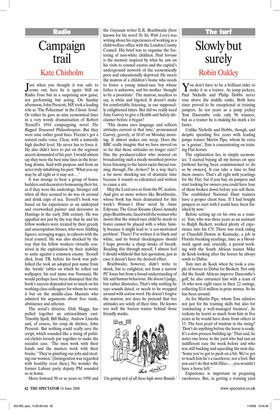Slowly but surely
Robin Oakley
You don’t have to be a brilliant rider to make it as a trainer. As jump jockeys, Paul Nicholls and Philip Hobbs never rose above the middle ranks. Both have since proved to be exceptional at training jumpers. In ten years as a jump jockey Tom Dascombe rode only 96 winners, but as a trainer he is making his mark a lot faster.
Unlike Nicholls and Hobbs, though, and despite spending five years with leading jumps trainer Martin Pipe, whom he rates as ‘a genius’, Tom is concentrating on training Flat horses.
The explanation lies in simple economics: ‘I started buying all my horses on spec [without having been commissioned to do so by owners]. It can take a time to find them owners. That’s all right with yearlings for the Flat, but if you buy six jumpers and start looking for owners you could have four of them broken down before you sell them. The established National Hunt trainers have a proper client base. If I had bought jumpers to start with I could have been finished by now.’ Before setting up on his own as a trainer, Tom, who was three years as an assistant to Ralph Beckett, worked plenty of experience into his CV. There was track riding at Churchill Downs in Kentucky, a job in Florida breaking yearlings, time as a bloodstock agent and, crucially, a period working with the South African trainer Mike de Kock looking after the horses he always sends to Dubai.
Tom met de Kock when he took a couple of horses to Dubai for Beckett. Not only did the South African improve Dascombe’s golf, he also entrusted him with a team of 16 who won eight races in their 22 outings, collecting $3.6 million in prize money. So he has been around.
As for Martin Pipe, whom Tom admires not just for his training skills but also for ‘conducting a well-managed business’, he reckons he learnt as much from him in five years as he would have done from others in 15. The best pearl of wisdom in the string? ‘Don’t do anything before the horse is ready. It’s a slow process building up.’ That said, he notes one horse in the yard who had run an indifferent race the week before and who was still bucking and squealing the next day. ‘Some you’ve got to push on a bit. We’ve got to teach him he’s a racehorse, not a fool. But you can’t do that with fillies ... you wouldn’t have a horse left.’ Experience is important in preparing racehorses. But, in getting a training yard off the ground, energy and moving with the times are equally important. And Tom, the first occupant of a purpose-built yard off Lambourn’s Folly Road, is very much the modern trainer. The lads and lasses jangling up to the gallops aboard his string all wear hats with red pom-poms and blue jackets bearing the One-Way logo which adorns his lively website. ‘We are always on show,’ says Tom, whose accountant father helped him cost out his business model and who appreciates the need for marketing.
‘Mind you,’ he says, ‘as the valet John Buckingham told me in my riding days, “It’s no use looking like you can do the job. You’ve actually got to do it.” As a jockey I was desperate to be better than Tony McCoy. There was no way it was ever going to happen. So if I failed as a jockey I’m going to work twice as hard at being a success in this next phase.’ You would have to say he is up to schedule. Tom started in 2006 with just nine horses, eight of which he owned himself, and a staff of four, including his girlfriend Michaela. In his first season he sent out the winners of 12 races. In his second there were 26. And as his website proudly proclaimed he had the sixth-best strike rate in the country. Only Sir Michael Stoute, Saeed bin Suroor, Jeremy Noseda, Sir Mark Prescott and Henry Cecil could better that.
There’s no mistaking the energy and enthusiasm of the hands-on trainer, with his trendily spiky blond hair and his capacity to drink coffee without spillage from a mug while piloting his 4X4 up to the gallops. But if the atmosphere in the yard is informal, there is also no question who is in charge. Nor about the confidence of a man who is prepared to buy the stock of unfashionable sires and who has therefore secured some good bargains for his owners.
This year there are 40 horses in the yard and Tom’s ambition is to train his first Group race winner. With horses like Zaskar, a daughter of Anabaa acquired for just 6,000 euros, on hand it should not be too long in coming. Winning at Great Leighs the rainsodden day I joined Tom on the Lambourn gallops, she looked highly promising.
The talented but wayward Max One Two Three, owned by Andrew Black and considered good enough for a 1,000 Guineas entry, is another potential star when they can settle her. ‘She’s a lovely filly. But she’s also bonkers, a bit of a spoilt cow.’ Another stable talent could be 7lb-claiming apprentice Ross Atkinson who has come from Gary Moore’s. I noted him riding a cool race from the front at Newbury recently to win on Clifton Dancer for Dascombe, who says of his new recruit: ‘As a jockey you can over time build on your strength. But he has also got a clock in his head, and if you haven’t got that you’ll never build it in.’ Tom Dascombe’s is not a betting yard. ‘I don’t bet because I can’t afford to lose.’ But it could be worth a few bob on him to meet the next target he has set.



















































































 Previous page
Previous page